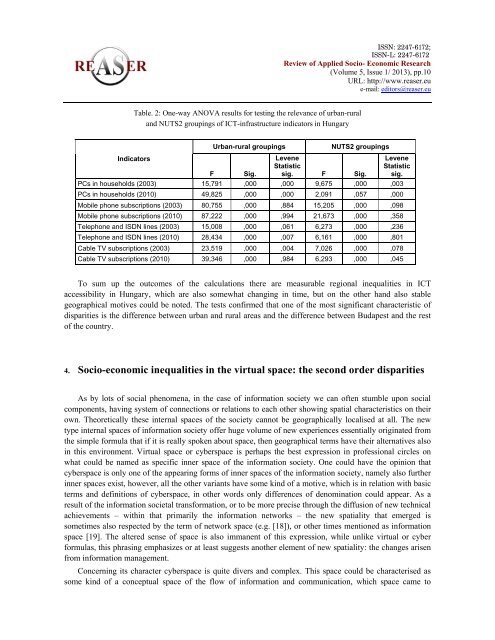new characteristics of inequalities in the information society and ...
new characteristics of inequalities in the information society and ...
new characteristics of inequalities in the information society and ...
You also want an ePaper? Increase the reach of your titles
YUMPU automatically turns print PDFs into web optimized ePapers that Google loves.
ISSN: 2247-6172;<br />
ISSN-L: 2247-6172<br />
Review <strong>of</strong> Applied Socio- Economic Research<br />
(Volume 5, Issue 1/ 2013), pp.10<br />
URL: http://www.reaser.eu<br />
e-mail: editors@reaser.eu<br />
Table. 2: One-way ANOVA results for test<strong>in</strong>g <strong>the</strong> relevance <strong>of</strong> urban-rural<br />
<strong>and</strong> NUTS2 group<strong>in</strong>gs <strong>of</strong> ICT-<strong>in</strong>frastructure <strong>in</strong>dicators <strong>in</strong> Hungary<br />
Urban-rural group<strong>in</strong>gs<br />
NUTS2 group<strong>in</strong>gs<br />
Indicators<br />
Levene<br />
Levene<br />
Statistic<br />
Statistic<br />
F Sig. sig. F Sig. sig.<br />
PCs <strong>in</strong> households (2003) 15,791 ,000 ,000 9,675 ,000 ,003<br />
PCs <strong>in</strong> households (2010) 49,825 ,000 ,000 2,091 ,057 ,000<br />
Mobile phone subscriptions (2003) 80,755 ,000 ,884 15,205 ,000 ,098<br />
Mobile phone subscriptions (2010) 87,222 ,000 ,994 21,673 ,000 ,358<br />
Telephone <strong>and</strong> ISDN l<strong>in</strong>es (2003) 15,008 ,000 ,061 6,273 ,000 ,236<br />
Telephone <strong>and</strong> ISDN l<strong>in</strong>es (2010) 28,434 ,000 ,007 6,161 ,000 ,801<br />
Cable TV subscriptions (2003) 23,519 ,000 ,004 7,026 ,000 ,078<br />
Cable TV subscriptions (2010) 39,346 ,000 ,984 6,293 ,000 ,045<br />
To sum up <strong>the</strong> outcomes <strong>of</strong> <strong>the</strong> calculations <strong>the</strong>re are measurable regional <strong><strong>in</strong>equalities</strong> <strong>in</strong> ICT<br />
accessibility <strong>in</strong> Hungary, which are also somewhat chang<strong>in</strong>g <strong>in</strong> time, but on <strong>the</strong> o<strong>the</strong>r h<strong>and</strong> also stable<br />
geographical motives could be noted. The tests confirmed that one <strong>of</strong> <strong>the</strong> most significant characteristic <strong>of</strong><br />
disparities is <strong>the</strong> difference between urban <strong>and</strong> rural areas <strong>and</strong> <strong>the</strong> difference between Budapest <strong>and</strong> <strong>the</strong> rest<br />
<strong>of</strong> <strong>the</strong> country.<br />
4. Socio-economic <strong><strong>in</strong>equalities</strong> <strong>in</strong> <strong>the</strong> virtual space: <strong>the</strong> second order disparities<br />
As by lots <strong>of</strong> social phenomena, <strong>in</strong> <strong>the</strong> case <strong>of</strong> <strong>in</strong>formation <strong>society</strong> we can <strong>of</strong>ten stumble upon social<br />
components, hav<strong>in</strong>g system <strong>of</strong> connections or relations to each o<strong>the</strong>r show<strong>in</strong>g spatial <strong>characteristics</strong> on <strong>the</strong>ir<br />
own. Theoretically <strong>the</strong>se <strong>in</strong>ternal spaces <strong>of</strong> <strong>the</strong> <strong>society</strong> cannot be geographically localised at all. The <strong>new</strong><br />
type <strong>in</strong>ternal spaces <strong>of</strong> <strong>in</strong>formation <strong>society</strong> <strong>of</strong>fer huge volume <strong>of</strong> <strong>new</strong> experiences essentially orig<strong>in</strong>ated from<br />
<strong>the</strong> simple formula that if it is really spoken about space, <strong>the</strong>n geographical terms have <strong>the</strong>ir alternatives also<br />
<strong>in</strong> this environment. Virtual space or cyberspace is perhaps <strong>the</strong> best expression <strong>in</strong> pr<strong>of</strong>essional circles on<br />
what could be named as specific <strong>in</strong>ner space <strong>of</strong> <strong>the</strong> <strong>in</strong>formation <strong>society</strong>. One could have <strong>the</strong> op<strong>in</strong>ion that<br />
cyberspace is only one <strong>of</strong> <strong>the</strong> appear<strong>in</strong>g forms <strong>of</strong> <strong>in</strong>ner spaces <strong>of</strong> <strong>the</strong> <strong>in</strong>formation <strong>society</strong>, namely also fur<strong>the</strong>r<br />
<strong>in</strong>ner spaces exist, however, all <strong>the</strong> o<strong>the</strong>r variants have some k<strong>in</strong>d <strong>of</strong> a motive, which is <strong>in</strong> relation with basic<br />
terms <strong>and</strong> def<strong>in</strong>itions <strong>of</strong> cyberspace, <strong>in</strong> o<strong>the</strong>r words only differences <strong>of</strong> denom<strong>in</strong>ation could appear. As a<br />
result <strong>of</strong> <strong>the</strong> <strong>in</strong>formation societal transformation, or to be more precise through <strong>the</strong> diffusion <strong>of</strong> <strong>new</strong> technical<br />
achievements – with<strong>in</strong> that primarily <strong>the</strong> <strong>in</strong>formation networks – <strong>the</strong> <strong>new</strong> spatiality that emerged is<br />
sometimes also respected by <strong>the</strong> term <strong>of</strong> network space (e.g. [18]), or o<strong>the</strong>r times mentioned as <strong>in</strong>formation<br />
space [19]. The altered sense <strong>of</strong> space is also immanent <strong>of</strong> this expression, while unlike virtual or cyber<br />
formulas, this phras<strong>in</strong>g emphasizes or at least suggests ano<strong>the</strong>r element <strong>of</strong> <strong>new</strong> spatiality: <strong>the</strong> changes arisen<br />
from <strong>in</strong>formation management.<br />
Concern<strong>in</strong>g its character cyberspace is quite divers <strong>and</strong> complex. This space could be characterised as<br />
some k<strong>in</strong>d <strong>of</strong> a conceptual space <strong>of</strong> <strong>the</strong> flow <strong>of</strong> <strong>in</strong>formation <strong>and</strong> communication, which space came to








